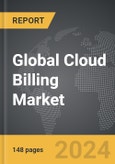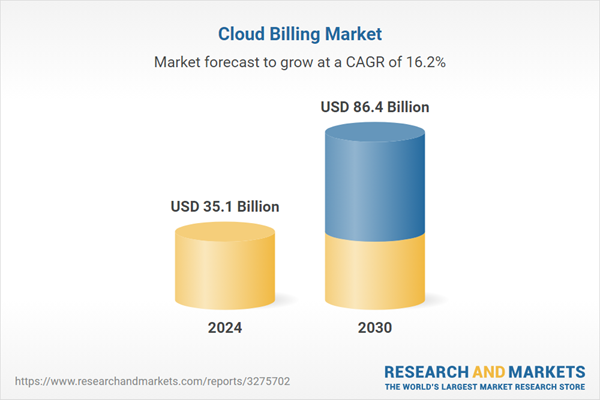The global market for Cloud Billing was valued at US$35.1 Billion in 2024 and is projected to reach US$86.4 Billion by 2030, growing at a CAGR of 16.2% from 2024 to 2030. This comprehensive report provides an in-depth analysis of market trends, drivers, and forecasts, helping you make informed business decisions. The report includes the most recent global tariff developments and how they impact the Cloud Billing market.
Scalability is a critical aspect of modern business operations, especially for companies looking to expand their customer base or enter new markets. Cloud-based billing systems offer the necessary elasticity to scale operations up or down based on real-time demand, avoiding the inefficiencies of underutilized capacity and the delays involved in scaling traditional systems. The integration capabilities of cloud billing platforms with other business systems, such as CRM, ERP, and tax payment gateways, are crucial for ensuring operational coherence and efficiency. These systems facilitate automated workflows and consistent data flow across different departments, enhancing overall business performance. The healthcare industry, for example, has adopted cloud-based medical billing and Electronic Health Records (EHRs) to streamline operations and improve service delivery, providing healthcare providers with reliable, instant access to patient health information and facilitating better communication with patients and other healthcare professionals.
The growth of cloud-based billing systems is driven by several key factors. Enhanced integration capabilities allow these systems to seamlessly connect with various business tools, supporting comprehensive operations. The adoption of subscription-based services has increased the demand for billing systems that can handle recurring payments and complex revenue management. Consumer preferences for digital services and the globalization of business operations require billing systems that provide real-time updates, handle multiple currencies, and comply with international regulations. The trend towards remote work and mobile accessibility has driven businesses to adopt cloud solutions for continuous access to billing data. Additionally, regulatory compliance and data security are crucial, with cloud-based systems offering built-in compliance and enhanced security features. Automated billing features, such as automated invoicing and payment reminders, reduce administrative burdens and minimize errors, further driving the adoption of cloud-based billing solutions. These factors collectively underscore the complex interplay of market trends, technological advancements, and evolving business models propelling the growth of cloud-based billing systems.
Segments: Type (Cloud Service Billing, Metered Billing, Provisioning, Subscription Billing, Other Types); Vertical (Telecommunications, BFSI, IT, Media & Entertainment, Consumer Goods & Retail, Healthcare, Education, Other Verticals).
Geographic Regions/Countries: World; United States; Canada; Japan; China; Europe (France; Germany; Italy; United Kingdom; and Rest of Europe); Asia-Pacific; Rest of World.
The analysts continuously track trade developments worldwide, drawing insights from leading global economists and over 200 industry and policy institutions, including think tanks, trade organizations, and national economic advisory bodies. This intelligence is integrated into forecasting models to provide timely, data-driven analysis of emerging risks and opportunities.
Global Cloud Billing Market - Key Trends and Drivers Summarized
In the competitive and rapidly evolving business landscape, companies are increasingly shifting from traditional on-premise billing systems to cloud-based solutions to maximize value for their customers and enhance revenue potential. This transition is driven by the cost-efficiency of cloud billing, which offers lower operating costs compared to traditional methods by eliminating the need for substantial investments in physical servers and ongoing maintenance. Cloud-based billing systems are hosted remotely and managed by software vendors, providing businesses with greater flexibility and easy configurability to meet changing requirements. This agility allows businesses to quickly adapt pricing models, expand into new markets, and respond swiftly to market opportunities and customer demands without extensive IT intervention.Scalability is a critical aspect of modern business operations, especially for companies looking to expand their customer base or enter new markets. Cloud-based billing systems offer the necessary elasticity to scale operations up or down based on real-time demand, avoiding the inefficiencies of underutilized capacity and the delays involved in scaling traditional systems. The integration capabilities of cloud billing platforms with other business systems, such as CRM, ERP, and tax payment gateways, are crucial for ensuring operational coherence and efficiency. These systems facilitate automated workflows and consistent data flow across different departments, enhancing overall business performance. The healthcare industry, for example, has adopted cloud-based medical billing and Electronic Health Records (EHRs) to streamline operations and improve service delivery, providing healthcare providers with reliable, instant access to patient health information and facilitating better communication with patients and other healthcare professionals.
The growth of cloud-based billing systems is driven by several key factors. Enhanced integration capabilities allow these systems to seamlessly connect with various business tools, supporting comprehensive operations. The adoption of subscription-based services has increased the demand for billing systems that can handle recurring payments and complex revenue management. Consumer preferences for digital services and the globalization of business operations require billing systems that provide real-time updates, handle multiple currencies, and comply with international regulations. The trend towards remote work and mobile accessibility has driven businesses to adopt cloud solutions for continuous access to billing data. Additionally, regulatory compliance and data security are crucial, with cloud-based systems offering built-in compliance and enhanced security features. Automated billing features, such as automated invoicing and payment reminders, reduce administrative burdens and minimize errors, further driving the adoption of cloud-based billing solutions. These factors collectively underscore the complex interplay of market trends, technological advancements, and evolving business models propelling the growth of cloud-based billing systems.
Report Scope
The report analyzes the Cloud Billing market, presented in terms of units. The analysis covers the key segments and geographic regions outlined below.Segments: Type (Cloud Service Billing, Metered Billing, Provisioning, Subscription Billing, Other Types); Vertical (Telecommunications, BFSI, IT, Media & Entertainment, Consumer Goods & Retail, Healthcare, Education, Other Verticals).
Geographic Regions/Countries: World; United States; Canada; Japan; China; Europe (France; Germany; Italy; United Kingdom; and Rest of Europe); Asia-Pacific; Rest of World.
Key Insights:
- Market Growth: Understand the significant growth trajectory of the Cloud Service Billing segment, which is expected to reach US$21.8 Billion by 2030 with a CAGR of a 8.0%. The Metered Billing segment is also set to grow at 23.9% CAGR over the analysis period.
- Regional Analysis: Gain insights into the U.S. market, valued at $10.0 Billion in 2024, and China, forecasted to grow at an impressive 15.7% CAGR to reach $13.4 Billion by 2030. Discover growth trends in other key regions, including Japan, Canada, Germany, and the Asia-Pacific.
Why You Should Buy This Report:
- Detailed Market Analysis: Access a thorough analysis of the Global Cloud Billing Market, covering all major geographic regions and market segments.
- Competitive Insights: Get an overview of the competitive landscape, including the market presence of major players across different geographies.
- Future Trends and Drivers: Understand the key trends and drivers shaping the future of the Global Cloud Billing Market.
- Actionable Insights: Benefit from actionable insights that can help you identify new revenue opportunities and make strategic business decisions.
Key Questions Answered:
- How is the Global Cloud Billing Market expected to evolve by 2030?
- What are the main drivers and restraints affecting the market?
- Which market segments will grow the most over the forecast period?
- How will market shares for different regions and segments change by 2030?
- Who are the leading players in the market, and what are their prospects?
Report Features:
- Comprehensive Market Data: Independent analysis of annual sales and market forecasts in US$ Million from 2024 to 2030.
- In-Depth Regional Analysis: Detailed insights into key markets, including the U.S., China, Japan, Canada, Europe, Asia-Pacific, Latin America, Middle East, and Africa.
- Company Profiles: Coverage of players such as Amazon Web Services, Inc., AMDOCS Ltd., Aria Systems, Inc., AsiaInfo Technology Holdings Co., Ltd., Cerillion Technologies Limited and more.
- Complimentary Updates: Receive free report updates for one year to keep you informed of the latest market developments.
Some of the 11 companies featured in this Cloud Billing market report include:
- Amazon Web Services, Inc.
- AMDOCS Ltd.
- Aria Systems, Inc.
- AsiaInfo Technology Holdings Co., Ltd.
- Cerillion Technologies Limited
- CGI Group, Inc.
- Chargebee Inc.
- Cloudability, Inc.
- Huawei Technologies Co., Ltd.
- IBM Corporation
- NEC Corporation
- NetCracker Technology Corp.
- Oracle Corporation
- SAP SE
- Tech Mahindra Ltd.
- Telefonaktiebolaget LM Ericsson
- Utilibill Pty Ltd
- Zuora, Inc.
Tariff Impact Analysis: Key Insights for 2025
Global tariff negotiations across 180+ countries are reshaping supply chains, costs, and competitiveness. This report reflects the latest developments as of April 2025 and incorporates forward-looking insights into the market outlook.The analysts continuously track trade developments worldwide, drawing insights from leading global economists and over 200 industry and policy institutions, including think tanks, trade organizations, and national economic advisory bodies. This intelligence is integrated into forecasting models to provide timely, data-driven analysis of emerging risks and opportunities.
What’s Included in This Edition:
- Tariff-adjusted market forecasts by region and segment
- Analysis of cost and supply chain implications by sourcing and trade exposure
- Strategic insights into geographic shifts
Buyers receive a free July 2025 update with:
- Finalized tariff impacts and new trade agreement effects
- Updated projections reflecting global sourcing and cost shifts
- Expanded country-specific coverage across the industry
Table of Contents
I. METHODOLOGYII. EXECUTIVE SUMMARY2. FOCUS ON SELECT PLAYERSIII. MARKET ANALYSISIV. COMPETITION
1. MARKET OVERVIEW
3. MARKET TRENDS & DRIVERS
4. GLOBAL MARKET PERSPECTIVE
UNITED STATES
CANADA
JAPAN
CHINA
EUROPE
FRANCE
GERMANY
ITALY
UNITED KINGDOM
REST OF EUROPE
ASIA-PACIFIC
REST OF WORLD
Companies Mentioned (Partial List)
A selection of companies mentioned in this report includes, but is not limited to:
- Amazon Web Services, Inc.
- AMDOCS Ltd.
- Aria Systems, Inc.
- AsiaInfo Technology Holdings Co., Ltd.
- Cerillion Technologies Limited
- CGI Group, Inc.
- Chargebee Inc.
- Cloudability, Inc.
- Huawei Technologies Co., Ltd.
- IBM Corporation
- NEC Corporation
- NetCracker Technology Corp.
- Oracle Corporation
- SAP SE
- Tech Mahindra Ltd.
- Telefonaktiebolaget LM Ericsson
- Utilibill Pty Ltd
- Zuora, Inc.
Table Information
| Report Attribute | Details |
|---|---|
| No. of Pages | 148 |
| Published | April 2025 |
| Forecast Period | 2024 - 2030 |
| Estimated Market Value ( USD | $ 35.1 Billion |
| Forecasted Market Value ( USD | $ 86.4 Billion |
| Compound Annual Growth Rate | 16.2% |
| Regions Covered | Global |









